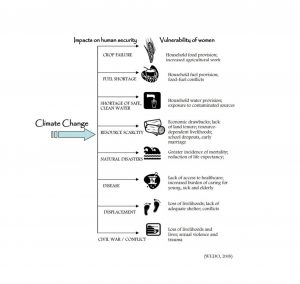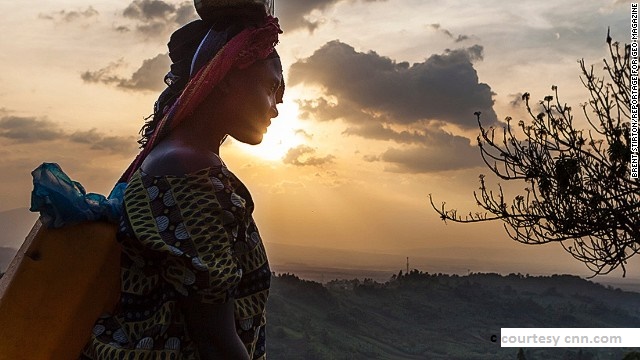Climate change is one of the greatest ecological and environmental challenges of our time. It is also an unquestionable encounter to human rights, security, and economic development. The impacts of climate change – floods, drought, extreme weather, increasing diseases and growing food and water insecurity – disproportionately affect the world’s 1.3 billion poor, the majority of whom are women. The diverse impacts of climate change on men and women are exacerbated in settings that are also affected by the violent encounter, political uncertainty, and economic conflict. As the world struggles to grapple with rapid disasters as well as answer to sluggish degradation caused by climate change, it is critical to ensure that the trouble of women is firmly on the agenda of concerns, and that women – from different backgrounds – are able to lead in negotiations and participate in the design and implementation of programs.

Although women are forced to accept the brunt of the consequences of climate change, they have been methodically excluded from decision-making mechanisms and denied agency in determining when and how to overcome the vulnerabilities they face. So, it is authoritative that we understand the impact of climate change on women, as well as the importance of their action in addressing its extortions.
read the road to sustainable energy production in Bangladesh
Climate change not only causes droughts and soil erosion, which disenfranchises women farmers, who are the majority of the agricultural workforce but also undermines hygiene and sanitation, affecting maternal health, women’s economic productivity, and girls’ education. Similarly, the gendered health, economic, and human security consequences of unmet energy needs of families that lack access to affordable and dependable energy sources have to be addressed.
Poverty and Inaccessibility to Resources Are Barricades
Women make up the majority of the world’s poor and are more reliant than men on resources for their livings and existence. Women tend to have lower incomes and are more likely to be economically dependent than men. When scarcity or unexpected rain, for example, threatens agricultural production, men can use their savings and economic independence to invest in alternative income sources or otherwise adapt. In times of food scarcity and drought, women will often give priority to their husbands—his alimentary needs will be met before hers. So, there are some significant development improvements that have to be made in ensuring women’s equitable access to and control over economic, financial and material resources, including in relation to economic growth, poverty eradication and the well-being of families and communities. The impact of inequality in access to resources represents their vulnerability to climate change as a global challenge with implications at individual, family, community and national level.
“Poverty is characterized not only by a lack of economic income but also by the inability to live a long and healthy life, to have full access to knowledge, to enjoy a decent
standard of living and to participate in the richness of the social, cultural and economic life of a community.”-United Nations Development Programs.
Unreachability to Education & Information Acts as a Barrier
Nearly two-thirds of the world’s illiterate adults are women, a fraction that has remained intractably unchanged for the past couple of years. This fact has forced women to be more vulnerable to climate change. They have less access to education and information that would allow them to tackle climate-related risks to agriculture and livestock. In Bangladesh, many women have considerably less access than men to critical evidence on weather alerts and harvesting arrangements, affecting their capacity to respond effectively to climate variability.
Responsibilities to Family Increases Women Vulnerability
Women are the first one in the family to have the core responsibilities for managing the household, even when they are not perceived as heads of household. In most of the world, women have engaged mothers and family care, givers. They have strong attachments to her family than the men which expose them to vulnerability at the time of any natural calamities like cyclone, flood etc. At the time of any disaster, men may be able to migrate for economic opportunities, but women are more likely to remain home to care for children and elderly or sick family members.
Climate change has a noteworthy impact on safeguarding household water, food, and fuel—activities that usually are the responsibility of women and girls. In times of drought and erratic rainfall, women and girls must walk a long distance and spend more of their time collecting water and fuel. Globally, women and children collectively spend 140 million hours per day collecting water for their families and communities, resulting in lost productive potential. Girls may have to drop out of school to help their mothers with these tasks, enduring the cycle of poverty, scarcity, and disproportion. Changing climates also affect the condition of crops, livestock and most importantly, women, who are often responsible for producing the food eaten at home, must work harder for less food.
High Fertility and Early Childbearing Aggravate Risks
A study found that, on average, natural catastrophes kill more women than men and subordinate the life expectancy of women more than men. The stronger the disaster, the stronger the impact on the gender gap. In the Asian tsunami of 2004, survival was much higher among men than women. This inequity can be endorsed by many possible and interconnected sources, but the fact that this effect is most prominent where women have lower socioeconomic status and power leads experts to believe that the causes are more cultural than biological or physiological. Early childbearing and high fertility are associated with poor health and lower levels of education and limit women’s ability to earn and save money and to acclimate to climate change.Yet, reproductive health and family planning are largely absent from strategies for familiarizing to climate change, as are activities that address rapid population growth and high fertility that result from unplanned pregnancies and an unmet need for family planning.
Nonexistence of Authority & Cultural Boundaries Play a Role
Lack of authority, independence and decision-making power limit women’s ability to adapt to climate change. Women often have limited or no control over family finances and properties. In many societies, women are underrepresented in community politics, considered as a second-class citizen and thus have little influence over community strategies for adapting and over policies that care for women’s rights, priorities and vulnerabilities. Without the contribution of women, agendas to replace traditional crops with those who are better suited to the changing environment might focus only on the requirements of men’s arenas and not address the problems women face.
Cultural boundaries on mobility can hinder women’s access to information and services. In addition, during extreme disasters, women may not be able to relocate and rearrange without the agreement of a male relative. Traditional clothing may impede women’s ability to run or swim, making it harder for them to escape disasters. Women who have lost attire in disasters may be less likely to access food and medical aid because they are unapt to enter public areas.
read saline water intrusion in the coastal area of Bangladesh
Let the Wind of Change Flow Everywhere
Women are strong embodiments of traditional and environmental familiarity collected from years of assisting their relatives, assembling and handling resources, and nurturing their families. When they are in control of assets, women are more likely than men to use them for family growth and economic constancy. Research also shows that women may be more likely to change tactics in response to new statistics and to make decisions that minimize risk. All these qualities firmly establish that when women are empowered and authorized, they can be extremely operative negotiators of adaptation to climate change. On top of everything, efforts to combat climate change cannot be as effective as intended if half the worlds population has no voice or presence in the legal frameworks guiding mitigation and adaptation processes. So let the wind of change flow everywhere to manage critical
components of climate change and create a sustainable future.
writer
Shooha Tabil
student, Bangladesh University of Engineering & Technology
